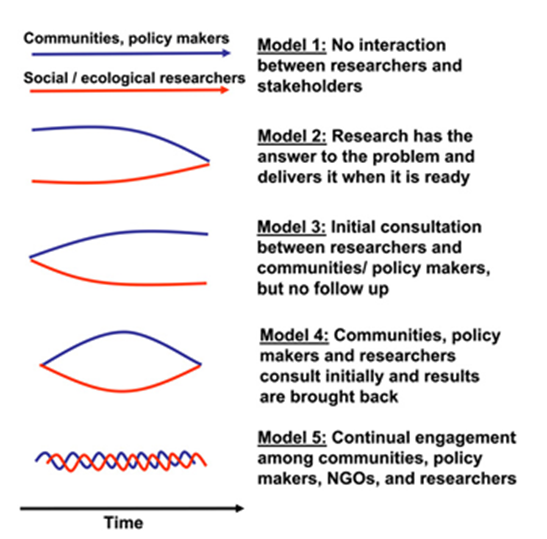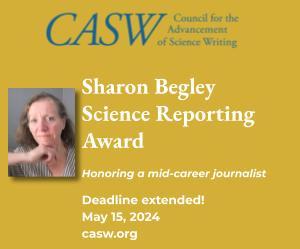This story was published as part of the 2024 Travel Fellowship Program to AAAS organized by the NASW Education Committee, providing science journalism practice and experience for undergraduate and graduate students.
Story by Olivia Maule
Mentored and edited by Elliot Richman
DENVER — Hundreds of data points connected by thousands of code-generated threads may give the impression that biologists scour hidden corners of the universe and navigate them wisely. Prevailing wisdom holds that failing to grasp a “deep understanding” of science emerges from confusion regarding the hard outputs of research like charts, manuscripts, and vocabulary. However, it turns out that the quest for deep understanding is hindered by the very experts who create these outputs.
Approaches to engagement
Many researchers have adjusted to the fast-paced nature of science, prioritizing quantity over quality. But some say that condensing projects into tight time frames has limited the freedom researchers have for deeply exploring subject areas from multiple facets, including culture. Although biological and cultural diversity are simultaneously threatened, they are able to sustain each other.
The bottom line is that their integration is crucial to advancement in science (Figure 1). By integrating people and their culture, scientists are better able to generate productive approaches to climate change — not just more of them.
“When we talk about protecting nature, we need to ask, what from… people?. But that’s not quite right. It leaves out diverse cultural institutions that have done quite well at protecting their nature,” says Dr. Erika Zalaveta, an ecologist at the University of California, Santa Cruz. During a Feb. 16 talk at the American Association for the Advancement of Science (AAAS) annual meeting, Zavaleta, a Howard Hughes Medical Institute Professor, discussed the valuable contributions made by cultural groups and conservation initiatives that prioritize diversity. These contributions vary from invoking millennium-old fire management approaches to integrating indigenous ecological knowledge into modern-day conservation policy.
Within the United States, research questions are constantly being generated. In fact, the U.S. produced around 442,000 research articles in 2018. Typically, once these questions are asked by principal investigators data are collected, then analyzed by students, and finally published as findings. Such a hierarchical and rigid structure, Zavaleta pointed out, contributes to a detachment some researchers experience in their work. However, she explained, for data collection specifically, there is an unavoidable interaction between researchers and communities where data are collected.
An ideal approach to cultural and biological diversity?
This interaction leads to five distinct engagement approaches: no interaction, forklift, no follow-up, bookends, and continual engagement (Figure 2). Continual engagement, an all-encompassing approach Zavaleta espouses, is based in the idea of “[flipping] whose goals are being served” with respect to agencies and tribes. Tribal entities in studied environments withhold the power to share or apply their own data, also known as data sovereignty. On the other hand, agencies incorporate additional data not found in tribal environments, which includes information acquired from other organizations or researchers. By understanding the people the research is intended to help through sustained interaction, Zavaleta explained, scientists’ conclusions can be efficiently applied.
Imagine this. You are at a doctor’s appointment, explaining your symptoms. Let’s choose back pain and headaches—a classic combo. You are prescribed an antibiotic that does absolutely nothing. The dim lighting of the doctor’s office greets you again, and you find your way back to your pharmacy with scrips for more useless antibiotics.
While this cycle fosters interaction, there is no engagement between physician and patient and, crucially, no possibility for an etiologic diagnosis. Now switch to ecology research: Zavaleta emphasized that questions designed to understand a group’s culture and behavior are optimal, especially for scientists interacting with communities outside of their own.
 Courtesy of Erika Zavaleta
Courtesy of Erika Zavaleta
Understanding the System
Indigenous communities, according to Zavaleta, understand the system and can engage in deep understanding. For instance, fire management strategies, also known as cultural burning, promote the growth of vegetation and biodiversity. Within California, for instance, the Uypi tribe has resided in the Santa Cruz area for at least 12,000 years. While they occupy only a small area, they possess a deep understanding of the land; they engaged with ‘cultural burning’ to conserve their environment. This practice mirrors instances in the Amazon, where forest loss in indigenous territories resembles loss in protected areas (Figure 3).
For researchers to blend the rapid pace of modern science with well-developed cultural practices, Zavaleta recommended that they match the pace of their community partners. This, she continued, requires dedicating portions of the project outside of data collection to building relationships with communities. Zavaleta compared this to learning a language. In the same way that one cannot fully learn Spanish, or feel Spanish, without being immersed in Spanish culture, she believes, “it is harmful to focus on the procedures rather than the process.”
Creating a Productive Research Program
According to Zavaleta, these changes begin at the very core of research: education. By transforming a structure focused on weed-out classes meant to filter out students unable to pass the course, she elaborated, to one focused on trans-disciplinary collaboration, there is an “emphasis on productivity, not regurgitation.” Engagement in field work also allows students to understand the very system they aim to change. Lastly, incorporating individuals from diverse background fosters what Zavaleta calls “beneficial friction” that encourages resilient solutions.
Olivia Maule is a junior at the University of Florida majoring in Biology and Anthropology. With an entomology and sustainability minor, she is known as ‘the bug girl’ by her friends. She is currently an intern for the United States Forest Service, where she writes content about international conservation initiatives in Latin and South America. Additionally, she creates videos and translations for the University of Florida Gulf Coast Research Center. You can also find her writing food articles (usually related to Taylor Swift) for Spoon University. Email her at olivia.maule@ufl.edu
Edited by Elliot Richman
Top Image: The Amazon rainforest is home to approximately 390 billion trees. However, each of those trees is at risk of being lost unless scientists approach conservation with the transdisciplinary mindset advocated by Stanford’s Zavaleta, which integrates traditional science with local culture. Credit: Olivia Maule
Founded in 1934 with a mission to fight for the free flow of science news, NASW is an organization of ~ 3,000 professional journalists, authors, editors, producers, public information officers, students and people who write and produce material intended to inform the public about science, health, engineering, and technology. To learn more, visit www.nasw.org.

.png)

